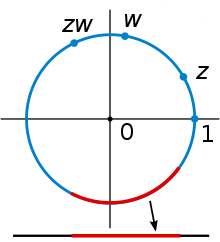U (1)
In physics and mathematics , the group is the simplest compact Lie group . Mathematically it is about the unit circle of the complex number plane with the group operation given by the multiplication of the complex numbers.
It is used, among other things, in the standard model of elementary particle physics .
definition
is the set of complex numbers of the form
(i.e. exactly the complex numbers of the amount ; note that and correspond to the same element)
with the group operations
and
The group is the special case of the unitary group for .
properties
- is isomorphic to the rotating group and to the circular group .
- is an Abelian group .
- is compact .
Representation theory
- All representations above are unitary .
- All irreducible representations above are 1-dimensional and are of form
- for a .
- It follows that any -dimensional representation is about from the form
- with , where on ( ) acts through multiplication with .
Charge operator
The charge operator for the representation is through the matrix
given,
physics
In quantum mechanics , particles are described by complex-valued wave functions and act on these wave functions by point-by-point phase transformation of the function value. That is a global gauge invariance. As a local gauge theory in which the phase is a function of space and time, the gauge group U (1) corresponds to quantum electrodynamics (and classical electrodynamics ). The eigenvalues of correspond to the electrical charge of the particles, with the phase being assumed. In quantum electrodynamics, the underlying space is the Minkowski space and the formalism of the theory of relativity is used for description. The (relativistic) vector potential corresponds here to the relationship on a U (1) principal bundle , the field strength tensor of the curvature-2-form of the bundle.
The rotations around a fixed axis can be identified with the group . The eigenvalues of the charge operator are interpreted as quantized angular momenta in the direction of the given axis.
The one-dimensional harmonic oscillator has -symmetry through rotations in the position-momentum-plane. In this case is a scalar multiple of the Hamilton operator .
In the standard model of elementary particle physics, the interaction of the matter fields is described by abstract (mathematical) gauge symmetries with the gauge groups , SU (2) and SU (3) . The last two calibration groups are non-Abelian and the associated field theories are called Yang-Mills theories . U (1) components also play a role as calibration groups in GUTs . They do not necessarily appear in the full calibration group, but rather when it disintegrates due to a spontaneous break in symmetry. But there are also more subtle applications of a U (1) symmetry (global and local) in elementary particle theory (see Axion ).
An example of the application in solid-state physics is the integer quantum Hall effect , whose integer quantum numbers of electrical conductivity are given by a topological invariant that corresponds to the first Chern class of a U (1) fiber bundle (for the identification of such and other topological phases in solid state physics, David J. Thouless received the 2016 Nobel Prize in Physics).






























